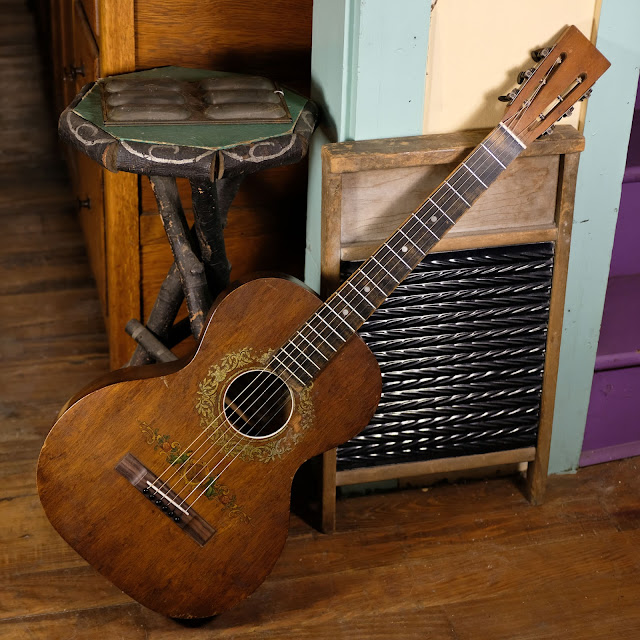1920s Oscar Schmidt-made Galiano 0-Size Flattop Guitar
While the average player might call this a "parlor" guitar, it's actually a 12-fret, 0-sized instrument with a 13 1/2" lower bout. I've worked on this same basic guitar model a half-dozen times and most of them use the Stella brand at the headstock. This one is interesting as it uses the Galiano moniker instead.
Still, aside from the fancy decals, it's a relatively basic Schmidt product: solid birch through the whole body and top, poplar neck, and ebonized-maple fretboard and bridge. This one was intended as a Hawaiian-strung guitar from the get-go and came with its original factory Hawaiian (very tall) nut. Most folks playing guitars like this are after a country-blues, ragtime, or fingerpicked-Americana vibe and so conversion to a "Spanish" guitar was the priority, here.
Work included a neck reset, fret level/dress, one brace replacement (upper bout top), install of a replacement rosewood bridge with compensated bone saddle, minor seam repairs to the top and back edges, and general setup work and side dots. It's playing perfectly with 3/32" EA and 1/16" DGBE action at the 12th fret and a straight neck. It's strung-up with 50w, 38w, 28w, 20w, 15, 11 "custom light" strings. The new drop-in saddle slot makes seasonal action adjustment easy, too. This has a 24 7/8" scale length.
Still, aside from the fancy decals, it's a relatively basic Schmidt product: solid birch through the whole body and top, poplar neck, and ebonized-maple fretboard and bridge. This one was intended as a Hawaiian-strung guitar from the get-go and came with its original factory Hawaiian (very tall) nut. Most folks playing guitars like this are after a country-blues, ragtime, or fingerpicked-Americana vibe and so conversion to a "Spanish" guitar was the priority, here.
Work included a neck reset, fret level/dress, one brace replacement (upper bout top), install of a replacement rosewood bridge with compensated bone saddle, minor seam repairs to the top and back edges, and general setup work and side dots. It's playing perfectly with 3/32" EA and 1/16" DGBE action at the 12th fret and a straight neck. It's strung-up with 50w, 38w, 28w, 20w, 15, 11 "custom light" strings. The new drop-in saddle slot makes seasonal action adjustment easy, too. This has a 24 7/8" scale length.
You can't argue too much with the cool decals or the "lived-in" looks of this guitar. It has use-wear throughout and the finish is scuffed, scratched, and marred here and there all over. The back and part of the sides has patches that seems to have been sanded-down at some point for no clear reason.
I had to replace the original Hawaiian-style nut, so this is a new, bone one. The nut width is 1 13/16" and the neck has a medium, V-shaped profile. The board itself is flat and has smallish brass frets.
The dots are pearl. Note the penciled-on numbers for each fret -- this was a system that was part of many introductory Hawaiian guitar lesson-books.
The decals that OS used around the soundholes have a reflective, metallic sort of presence to them. The only binding on the guitar is the bit around the soundhole.
The new, rosewood bridge serves a lot better than the uncompensated, celluloid-saddle, crack-prone maple monstrosity that the guitar was built with. I did save the original bridge and what was left of the bridge pins in a baggie, however.
The saddle has good height and string ramps behind it provide great back-angle to drive the top. The top itself is ladder-braced with two main lower bout braces and a big, wide, bridge plate/strapping brace between them. This is a bit lighter than many of the intended-for-fretted-play Oscar Schmidt builds and part of the reason the guitar sounds lively.
You can see the discoloration to the finish on the bass side of the instrument's back. It's either moisture damage or sanding work. Either way it doesn't hurt the instrument, really.
There are two small hairline cracks on the back (repaired) and plenty of scratches. The only other crack on the instrument is a tiny one I cleated just below the fretboard extension on the top.
The original tuners are lubed and work just fine.
Here you can see some other finish muck on the side near the endpin in this pic. Right next door is a reglued seam. There are a few of these seams that were reglued in the past a bit sloppily and I had to take them apart and reglue them again. This yielded a not-perfectly-straight edge in two spots -- this is one of them. They're nothing to worry about but I like to be thorough.




















Comments